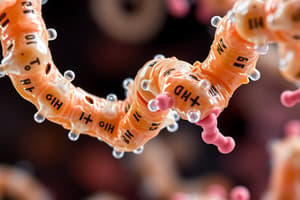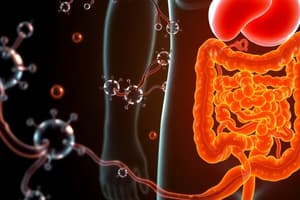Podcast
Questions and Answers
Which condition is associated with a marked increase in plasma creatine kinase activities?
Which condition is associated with a marked increase in plasma creatine kinase activities?
- Intramuscular injection
- Physical exertion
- Dermatomyositis (correct)
- Hypothyroidism
Salivary gland disorders can cause a marked increase in serum amylase levels.
Salivary gland disorders can cause a marked increase in serum amylase levels.
False (B)
What enzyme breaks down starch and glycogen in the serum?
What enzyme breaks down starch and glycogen in the serum?
amylase
A marked increase in plasma amylase activity may indicate conditions like acute pancreatitis and __________.
A marked increase in plasma amylase activity may indicate conditions like acute pancreatitis and __________.
Match the following causes of increased amylase activity with their corresponding types:
Match the following causes of increased amylase activity with their corresponding types:
Which of the following conditions can cause a marked increase in plasma AST activity?
Which of the following conditions can cause a marked increase in plasma AST activity?
Alanine aminotransferase (ALT) is also known as glutamate oxaloacetate aminotransferase (GOT).
Alanine aminotransferase (ALT) is also known as glutamate oxaloacetate aminotransferase (GOT).
Name one organ where both AST and ALT are present in high concentrations.
Name one organ where both AST and ALT are present in high concentrations.
A marked increase in plasma ALT activity may indicate __________.
A marked increase in plasma ALT activity may indicate __________.
Match the enzyme with its corresponding activity:
Match the enzyme with its corresponding activity:
What condition is most likely diagnosed in the presented clinical scenario?
What condition is most likely diagnosed in the presented clinical scenario?
Enzymology refers to the study of enzymes present exclusively in the plasma.
Enzymology refers to the study of enzymes present exclusively in the plasma.
What does ALP stand for in the context of serum enzyme tests?
What does ALP stand for in the context of serum enzyme tests?
The enzyme activity in plasma may be ______ than normal due to cell damage or increased cell turnover.
The enzyme activity in plasma may be ______ than normal due to cell damage or increased cell turnover.
Match the enzymatic activity to its possible reason for elevation:
Match the enzymatic activity to its possible reason for elevation:
Which of the following enzyme activities is normally found at low levels in serum?
Which of the following enzyme activities is normally found at low levels in serum?
Isoenzyme determination can enhance diagnostic accuracy in enzymology.
Isoenzyme determination can enhance diagnostic accuracy in enzymology.
What is indicated by an increase in enzyme levels in plasma?
What is indicated by an increase in enzyme levels in plasma?
What is a marked increase in plasma total LDH activity associated with?
What is a marked increase in plasma total LDH activity associated with?
LDH1 is primarily associated with the liver.
LDH1 is primarily associated with the liver.
Name one condition that can lead to a slight increase in LDH activity.
Name one condition that can lead to a slight increase in LDH activity.
The isoenzyme LDH4 has __________ significance.
The isoenzyme LDH4 has __________ significance.
Match the following isoenzymes of LDH with their primary source or elevation condition:
Match the following isoenzymes of LDH with their primary source or elevation condition:
Which laboratory enzyme isoform predominates in cardiac muscle?
Which laboratory enzyme isoform predominates in cardiac muscle?
CK-3 isoenzyme is predominant in the brain.
CK-3 isoenzyme is predominant in the brain.
What type of macroenzyme is associated with autoimmune disease like rheumatoid arthritis?
What type of macroenzyme is associated with autoimmune disease like rheumatoid arthritis?
Flashcards are hidden until you start studying
Study Notes
Enzymes
- Enzymology is the study of enzymes in body fluids, commonly used for diagnosis and monitoring of conditions
- Measuring plasma enzyme activity has limits, as it lacks specificity
- Isoenzymes, differing molecular variants of enzymes, and measuring multiple enzymes improve diagnostic accuracy
- Functional plasma enzymes are present at all times in circulation, performing physiological functions in the blood
- Non-functional plasma enzymes lack specific function in plasma, and function inside cells
- Non-functional enzymes are released during normal cell turnover
- Low levels are present in serum, but levels rise in tissue injury, helping diagnose the site and extent of injury
Steady-state of Enzyme Activity
- Normally, plasma enzyme activity indicates a steady-state
- The rate of enzyme entry into plasma equals the rate of enzyme removal
Enzyme Activity Abnormalities
- Higher than normal plasma enzyme activity can be due to:
- Proliferation of cells, increasing cell turnover or damage
- Increased rate of cell turnover or damage
- Increased enzyme synthesis (induction)
- Reduced clearance from the plasma
- Lower than normal plasma enzyme activity can be due to:
- Reduced enzyme synthesis, congenital deficiency, or inherited variants with low biological activity
- Presence of macroenzymes, high-molecular-weight forms of native enzymes, often complexed with immunoglobulins, common in autoimmune diseases
Clinically Important Plasma Enzymes
Aminotransferases
- Transfer amino groups from one molecule to another
- Two important aminotransferases are aspartate aminotransferase (AST) and alanine aminotransferase (ALT)
Aspartate Aminotransferase (AST)
- Also known as glutamate oxaloacetate aminotransferase (GOT)
- Catalyzes the transfer of an amino group from aspartate to α-ketoglutarate, forming oxaloacetate and glutamate
- Found in high concentrations in:
- Cardiac muscle
- Erythrocytes
- Skeletal muscle
- Liver
- Kidneys
Causes of Raised Plasma AST Activity
- Artefactual: In vitro release from RBC due to hemolysis
- Marked increase (greater than 5-10 times the upper reference limit or URL): Note: URL is the reference range for AST activity.
- Circulatory failure with shock and hypoxia
- Myocardial infarction
- Acute viral or toxic hepatitis
- Moderate to slight increase (less than 5 times URL):
- Cirrhosis
- Liver tumors
- Skeletal muscle disease
Alanine Aminotransferase (ALT)
- Also known as glutamate pyruvate aminotransferase (GPT)
- Catalyzes the transfer of an amino group from alanine to α-ketoglutarate, forming glutamate and pyruvate
- Found in high concentrations in:
- Liver
- Skeletal muscle
- Kidneys
- Cardiac muscle
Causes of Raised Plasma ALT Activity
- Marked increase (greater than 5-10 times URL): Note: URL is the reference range for ALT activity.
- Circulatory failure with shock and hypoxia
- Acute viral or toxic hepatitis
- Moderate to slight increase (less than 5 times URL):
- Liver cirrhosis
- Liver tumors
Lactate Dehydrogenase (LDH)
- Catalyzes the reversible conversion of lactate to pyruvate using NAD+ as a cofactor
- Found in many tissues, including:
- Skeletal muscle
- Kidneys
- Brain
- Cardiac muscle
- Liver
- RBCs
Causes of Raised Plasma Total LDH Activity
- Artefactual: In vitro hemolysis
- Marked increase (greater than 5-10 times URL): Note: URL is the reference range for LDH activity.
- Circulatory failure with shock and hypoxia
- Myocardial infarction
- Some hematological disorders: Megaloblastic anemia, acute leukemia, and lymphomas
- Moderate to slight increase (less than 5 times URL):
- Viral hepatitis
- Malignancy of any tissue
Isoenzymes of LDH
- Five main isoenzymes can be detected by electrophoresis: LDH1 to LDH5
- Each isoenzyme consists of two different kinds of polypeptide chains, designated as H and M
- Isoenzyme and tissue distribution:
- LDH1: H4 - Heart - Elevated in Myocardial Infarction (MI)
- LDH2: H3M1 - Heart, Kidney, RBCs - Elevated in MI and hemolytic anemia
- LDH3: H2M2 - Widely distributed - Elevated in malignancy of many tissues
- LDH4: H1M3 - Widely distributed - Little diagnostic significance
- LDH5: M4 - Liver, Skeletal muscle - Elevated in skeletal muscle and liver diseases
Creatine Kinase (CK)
- Catalyzes the reversible phosphorylation of creatine to creatine phosphate, using ATP
- Found in high concentrations in:
- Skeletal muscle
- Cardiac muscle
- Brain
Isoenzymes of Creatine Kinase
- Three principal isoenzymes: BB, MB, and MM
- Each isoenzyme consists of two polypeptide chains: B (brain) or M (muscle)
- Isoenzyme and tissue distribution:
- BB (CK-1): Predominant in brain
- MB (CK-2): Predominant in cardiac muscle
- MM (CK-3): Predominant in skeletal muscle
Other Forms of CK
- Mitochondrial CK: Found in hepatic disease, certain tumors, and critically ill patients
- Type 1 Macroenzyme: Associated with autoimmune disease, like rheumatoid arthritis, thought to be CK complexed with IgG
- Type 2 Macroenzyme: An oligomer of mitochondrial CK
Causes of Raised Plasma Creatine Kinase Activities
- Marked increase (greater than 5-10 times URL): Note: URL is the reference range for CK activity.
- Dermatomyositis and polymyositis
- Shock and circulatory failure
- Myocardial infarction
- Moderate to slight increase (less than 5 times URL):
- Muscle injury
- Physical exertion
- After an intramuscular injection
- Hypothyroidism
- Certain drugs: statins, ciclosporin, cocaine
Amylase
- Breaks down starch and glycogen
- Serum amylase originates mainly from the pancreas (P-isoamylase) and salivary glands (S-isoamylase)
- Can also be extracted from other tissues: gonads, Fallopian tubes, skeletal muscle, and adipose tissue
- Excreted in urine due to its low molecular weight
Causes of Raised Plasma Amylase Activity
- Marked increase (greater than 5-10 times URL): Note: URL is the reference range for amylase activity.
- Acute pancreatitis
- Severe glomerular impairment
- Diabetic ketoacidosis
- Perforated peptic ulcer
- Moderate to slight increase (less than 5 times URL):
- Other acute abdominal disorders: acute cholecystitis, intestinal obstruction
- Salivary gland disorders: mumps, salivary calculi
- Decreased amylase activity:
- Chronic pancreatic disease
Macroamylasaemia
- High plasma amylase activity due to low renal excretion of a macroenzyme form, despite normal glomerular function
- Symptomless, thought to be the enzyme bound to IgA, forming a complex with a molecular weight of about 270 kDa
Lipase
- Derived from the pancreas, more specific for pancreatic pathology
- Longer half-life than amylase, making it more useful for diagnosis of late-presenting acute pancreatitis
Studying That Suits You
Use AI to generate personalized quizzes and flashcards to suit your learning preferences.





